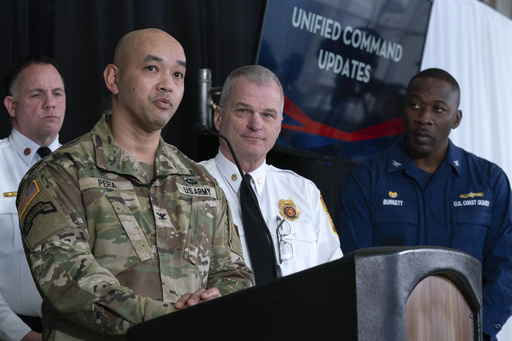ARLINGTON, Va. — On Sunday, families of the victims involved in the tragic air calamity, the deadliest in the U.S. since 2001, visited the site of the crash. Meanwhile, divers worked hard to scavenge the submerged wreckage in hopes of recovering additional remains. Authorities confirmed they had already identified 55 of the 67 individuals who perished in the incident.
Washington D.C. Fire and EMS Chief John Donnelly expressed confidence that all missing remains would eventually be uncovered. Divers are actively engaged in the recovery process, while preparations are underway to hoist the wreckage from the cold waters of the Potomac River as early as Monday morning, according to statements made during a press briefing.
Colonel Francis B. Pera from the Army Corps of Engineers reiterated the importance of strict safety protocols being implemented by divers and salvage crews. He mentioned that operations would be halted if any remains were discovered, emphasizing that “the dignified recovery” of the victims is a top priority.
“The mission of reuniting the lost souls from this heartbreaking event is what drives all of us,” said Pera. He noted the dedication of the teams who have been working tirelessly to achieve this goal since the beginning of the recovery process.
Divers are equipped with high-definition cameras whose feeds are monitored from support boats, ensuring multiple eyes are on the wreckage. Given the chilling conditions, one diver required hospitalization for hypothermia, as Donnelly reported.
On Wednesday night, two aircraft collided over the Potomac River near Reagan Washington National Airport; an American Airlines flight carrying 64 individuals and an Army Black Hawk helicopter with three crew members. The American Airlines jet was preparing to land, while the Black Hawk was on a training mission. There were no survivors from either craft.
Federal investigators are currently piecing together the circumstances leading to the fatal collision. While the National Transportation Safety Board opted not to hold a press briefing on Sunday, they did release images of investigators examining wreckage on a small boat, as well as reviewing a flight data recorder.
Transportation Secretary Sean Duffy emphasized the need to allow investigators adequate time to carry out their examination but posed critical questions during a Sunday morning television appearance. He inquired about staffing levels in the control towers and various factors such as the positioning and altitude of the Black Hawk, questioning whether its pilots were using night vision goggles.
Among the Black Hawk crew members were Army Staff Sgt. Ryan Austin O’Hara, Chief Warrant Officer 2 Andrew Loyd Eaves, and Capt. Rebecca M. Lobach. Passengers on the American Airlines flight included figure skaters returning from the 2025 U.S. Figure Skating Championships and a group of hunters concluding a guided excursion.
Reports from the NTSB indicated that preliminary data revealed conflicting altitude readings from both the jet and the helicopter. Just before impact, the flight recorder indicated a change in the jet’s pitch, but officials have yet to determine if this was an attempt for evasive action.
Data indicated that the jet was at an altitude of 325 feet when the collision occurred, while control tower records showed the Black Hawk was at the maximum permitted altitude of 200 feet. The exact cause of this discrepancy remains under investigation.
Investigators hope to clarify the conflicting information through data retrieved from the helicopter’s black box and by reassessing existing tower data, which can sometimes lack accuracy. “This is a complex investigation,” said lead investigator Brice Banning, indicating that many factors are at play.
Insights from the jet’s cockpit voice recorder captured critical moments leading up to the crash, with Banning relaying that the flight crew exhibited a verbal reaction. The voice recorder also documented a shift in the airplane’s pitch moments before the crash, with impact sounds recorded one second later.
Typically, thorough investigations can take a year or longer, yet the NTSB anticipates a preliminary report could be released within 30 days. NTSB member Todd Inman shared that he has been in close contact with the victims’ families, and he has witnessed a range of emotions, from anger to sorrow, as they seek answers.
More than 300 responders have been involved in the recovery efforts, with two Navy barges deployed to assist in recovering heavy debris. Following the incident, the FAA has also taken steps to restrict helicopter traffic around Reagan Airport, particularly after President Trump raised concerns about the altitude of a helicopter involved in a previous incident.
The crash on Wednesday was marked as the deadliest in the United States since a catastrophic event on November 12, 2001, when a jet hit a neighborhood in New York City shortly after takeoff, claiming the lives of 260 individuals aboard and five people on the ground.
Experts continue to assure that air travel remains statistically safe; however, the densely populated airways around Reagan Airport pose significant challenges even for seasoned pilots.



